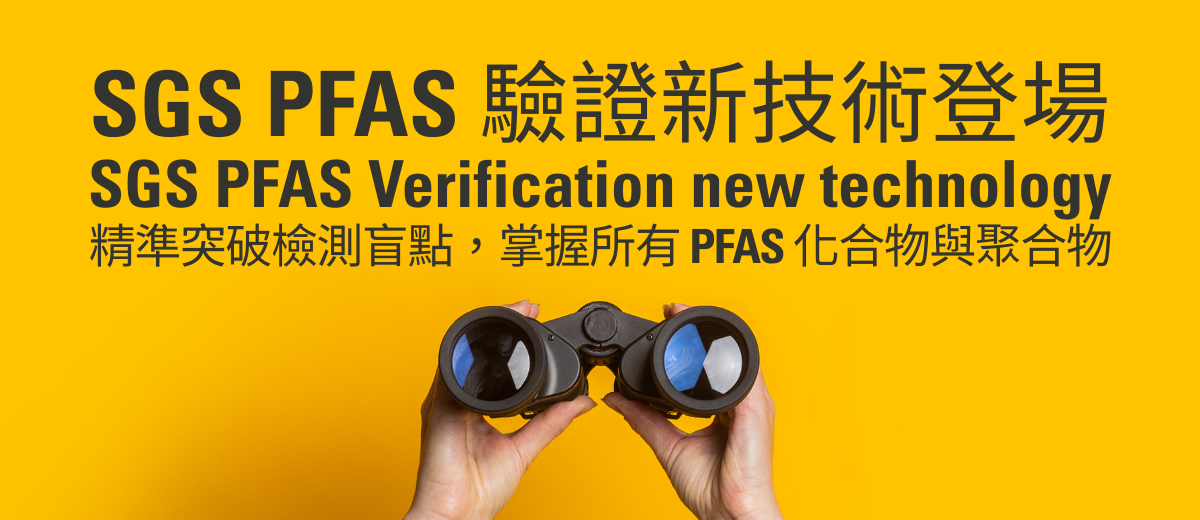Introducing New SGS PFAS Verification Technology
PFAS (Per- and Polyfluoroalkyl Substances) are globally recognized as "forever chemicals" of high concern. Their defining characteristic is the extremely stable carbon-fluorine (C–F) bond, which makes them almost non-degradable in the environment. As a result, PFAS persist and accumulate, causing long-term impacts on both the environment and human health. Whether it’s the European Union’s stringent concentration limits or the United States’ mandatory reporting requirements for any detected PFAS, manufacturers are being challenged with the question: “Do you truly understand the composition of your products?”

Our team in Taiwan at C&P’s Chemical Analysis and Sustainability Services has developed an innovative PFAS Verification service capable of simultaneously detecting PFAS compounds and polymers. This comprehensive and accurate solution enables businesses to quickly meet diverse regulatory demands across global markets.
PFAS 101: Key Chemical Insights You Should Know
From a chemical perspective, fluorine-containing substances fall into two major categories:
- Inorganic Fluorine
- Examples: Calcium fluoride (CaF₂), Sodium fluoride (NaF)
- Commonly found in industrial raw materials and additives
- Organic Fluorine
- Organic compounds containing carbon-fluorine bonds, including:
- PFAS Compounds: such as PFOA and PFOS; small molecules with high mobility
- PFAS Polymers: such as PTFE (Teflon); high molecular weight, used in non-stick cookware, sealing materials, etc
- Non-PFAS Organic Fluorine: such as CFCI₃; used in refrigerants, foaming agents, etc
- Organic compounds containing carbon-fluorine bonds, including:
Why Is PFAS So Difficult to Detect?
Common industry testing methods and their limitations include:
- Total Fluorine Test (TF)
- Covers all organic and inorganic fluorine, but cannot directly determine whether the fluorine in the sample originates from PFAS
- Detection limit is at the ppm level, making it unsuitable for assessing compliance with PFAS-related regulatory requirements
- Total Organic Fluorine Test (TOF)
- Focuses on organic fluorine, yet still cannot directly determine whether the fluorine in the sample comes from PFAS
- Detection limit is at the ppm level, making it unsuitable for assessing compliance with PFAS-related regulatory requirements
- Targeted PFAS Compounds Analysis
- Detection limits can reach the ppb level, but only for PFAS compounds with available reference standards
- Cannot detect PFAS polymers or identify unknown PFAS substances
This explains why many past total fluorine reports showed high fluorine content but failed to confirm if restricted PFAS were truly present—this is the blind spot in PFAS detection.
SGS PFAS Verification: Three Major Technological Breakthroughs
Our new technology overcomes the limitations of traditional testing by detecting characteristic functional groups of PFAS in samples, enabling analysis without relying on PFAS reference standards. This breakthrough delivers two key advantages:
- High Accuracy: Accurately determines the presence of PFAS in a sample even without PFAS reference standards
- Comprehensive Coverage: Assesses risks from both PFAS compounds and PFAS polymers in a single evaluation
- Regulatory Compliance Friendly: Easier alignment with varying PFAS testing requirements worldwide
Why Did We Develop This Technology?
Global PFAS Regulatory Trends and Challenges
PFAS regulations are tightening worldwide, but definitions and requirements vary by country and region, posing challenges for multinational companies. For example:
EU PFAS Regulations
- PFAS compounds with standards (acids and salts): concentration limit at 25 ppb
- PFAS-related substances with standards: sum concentration limits apply
- PFAS polymers: if total fluorine (TF) > 50 ppm, companies must prove the fluorine source is not PFAS
US PFAS Regulations
- Based on TSCA (Toxic Substances Control Act) framework
- Any detected PFAS, regardless of concentration, must be reported
Challenges
- Different detection thresholds across regions make a single test method insufficient
- Businesses need a new solution capable of detecting both PFAS compounds and polymers simultaneously
Conclusion
The new PFAS Verification technology is not just a detection innovation; it is a powerful tool that boosts corporate confidence in global compliance. It answers the critical question:
“Does my product contain any PFAS compounds or polymers?” By providing scientific evidence, it helps you overcome regulatory barriers in different markets.
If you still feel unclear about the differences between PFAS compounds and polymers, that’s okay—start by asking yourself: Do I know if my products contain PFAS?
If the answer is “uncertain,” that’s exactly where we can help.
To know more: SGS PFAS Verification Service|Comprehensive Risk Detection for Compounds and Polymers - SGS Taiwan

